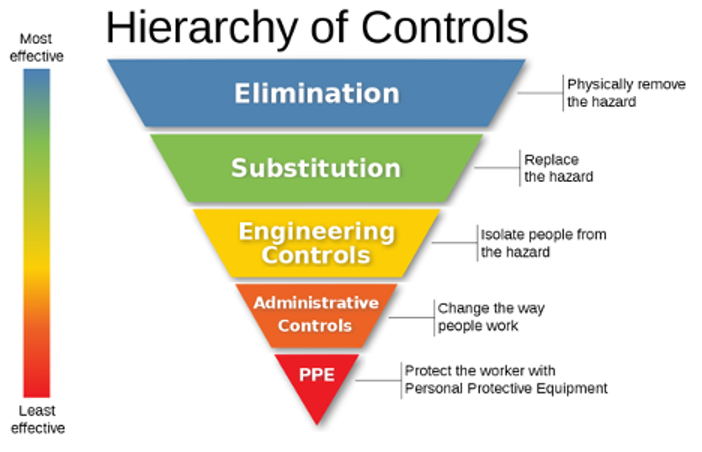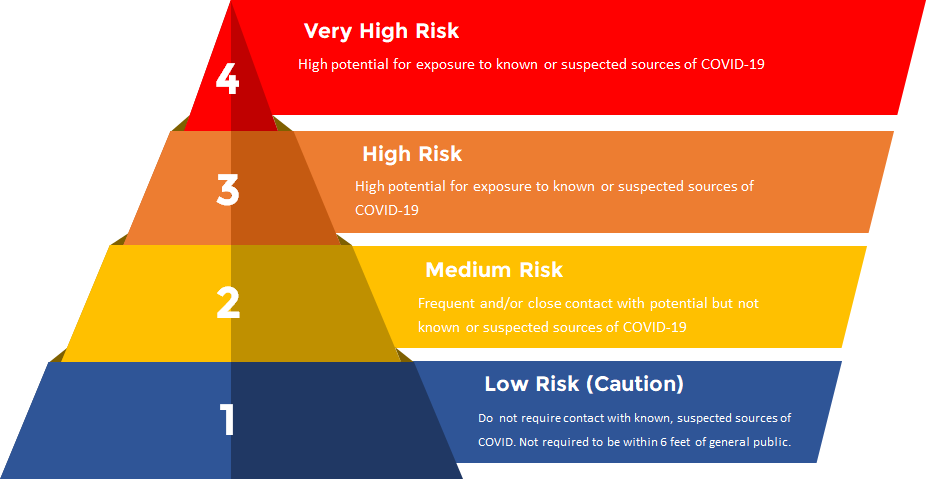Job Safety Assessment & Risk Analysis
What is a Job Safety Assessment (JSA)?
The Environmental Health and Safety (EHS) team at Teachers College is responsible for performing the Job Safety Assessment (JSA) for all job functions on campus. The basic principle of the JSA is to break down the work to be performed into distinct tasks, and then analyze each distinct work task for potential safety risks or hazards. The JSA may also include other elements such as property damage and research quality. Here, we will only consider what could happen to the worker and what performance requirements are needed in Personal Protective Equipment (PPE) for purposes of this assessment. The JSA also includes a “what if” analysis for non-routine and disrupted conditions. Assessing potential outcomes is necessary because accidents commonly result from deviations in work practices and normal operations. For this scenario, the EHS team utilizes the OSHA Hierarchy of Controls to perform the JSA.
Hierarchy of Controls
Controlling exposures to occupational hazards is the fundamental method of protecting workers. Traditionally, a hierarchy of controls determines how to implement feasible and effective control solutions. This hierarchy is as follows:

Image Source: CDC.org
Elimination and Substitution: While most effective at reducing hazards, these controls are often difficult to implement in an existing process. If the process is still at the design or development stage, elimination and substitution of hazards may be inexpensive and simple to implement. For an existing process, major changes in equipment and procedures may be required to eliminate or substitute for a hazard.
Engineering Controls: These are favored approaches over administrative changes and PPE requirements for controlling existing worker exposures in the workplace, because they are designed to remove the hazard at the source before it comes in contact with the worker. Well-designed engineering controls can be highly effective in protecting workers and will typically be independent of worker interactions to provide this high level of protection. The initial cost of engineering controls can be higher than the cost of administrative controls or PPE. Over the longer term however, operating costs are frequently lower, and in some instances, can provide cost savings in other areas of the process. Engineering controls are beneficial for users who need control solutions to reduce or eliminate worker exposures.
Administrative Controls and PPE: These controls are frequently used with existing processes where hazards are not particularly well controlled. Administrative controls and PPE programs may be relatively inexpensive to establish but, over the long term, can be very costly to sustain. These methods for protecting workers have also proven to be less effective than other measures, requiring significant effort by the affected workers. Depending on the conditions in the Research Lab environment, the EHS team will be utilizing the following hierarchy of controls:
- Elimination (Unachievable prior to vaccine)
- Substitution (Unachievable)
- Engineering Controls: Social distancing
- Administrative Controls: Rescheduling work, emergency work only, implementing changes in policies and procedures, cleaning and sanitizing of premises and equipment as per CDC recommendations
- PPE: Face coverings are required for everyone on campus. However, since there is no way to rule out the possibility that occupants of a research space may have been exposed to the COVID-19 virus, the EHS team may recommend the following additional PPE requirements (and associated trainings) where applicable:
- Tyvek coveralls/Lab coats
- Face masks, KN95, N95 or greater respirator
- Face shields
- Latex gloves
- Safety glasses
Classifying Worker Exposure to SARS‑CoV-2
The EHS team also determines the risk of occupational exposure to SARS-CoV-2, the virus that causes COVID-19. During an outbreak, the risk may vary from very high to high, medium, or lower (caution) risk. The level of risk depends in part on the industry type, need for contact within 6 feet of people known to be, or suspected of being, infected with SARS-CoV-2, or requirement for repeated or extended contact with persons known to be, or suspected of being, infected with SARS-CoV-2. To help employers determine appropriate precautions, OSHA has divided job tasks into four risk exposure levels: very high, high, medium, and lower risk. For example, researchers engaged in high-physical-contact studies with vulnerable research populations would likely be deemed “high risk.” This risk assessment may lead to the researcher needing to take additional training modules on how to use specialized personal protective equipment.
The Occupational Risk Pyramid shows the four exposure risk levels in the shape of a pyramid to represent probable distribution of risk. Although most on-campus researchers will likely fall in the lower exposure risk (caution) or medium exposure risk levels, the EHS team will take the most conservative approach to assign appropriate risk categories during the JSA and Risk Analysis.

Image Source: OSHA Risk of COVID-19
Physical Tour
In addition to the Job Safety Assessment & Risk Analysis (JSA), the EHS team in collaboration with the Office of Facilities will conduct physical tours of all research labs to ensure that all measures for social distancing are in place.
Communication
Upon completion of the JSA, the EHS team will communicate the results of the JSA to the research lab management, including at minimum the following information:
- Name and Location of Research Lab or space
- Summary of research functions (as staff or when engaging with research participants)
- Contact information (and Research Safety Monitor designation)
- Numbers of people working in the Research Lab or space
- Risk Level for research personnel depending on functions
- PPE required
- Any Administrative Controls to be put in place
- Training Required (in addition to the General Return to Campus Training and Research-Specific Training Modules)
The EHS team will also communicate with the IRB and Risk Assessment Office, as applicable, to discuss any recommendations they provided to research personnel. This interdepartmental collaboration will ensure that all related content is shared and implemented appropriately.